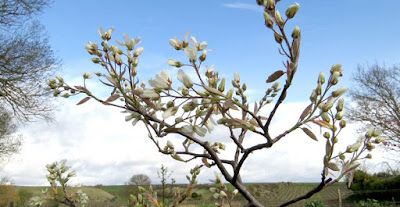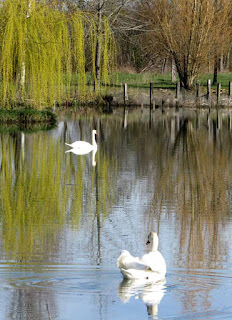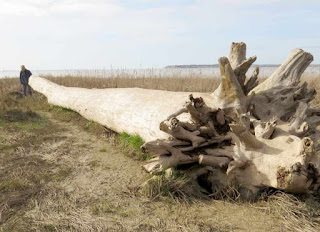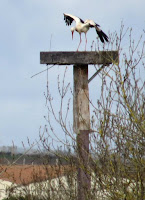"And since to look at things in bloom
Fifty springs are little room..."
Fifty springs are little room..."
- A E Houseman
 |
| Amelanchier lamarckii - a graceful harbinger of Spring |
Amelanchier
According to the RHS, this poetic-sounding tree is more generally known as 'Snowy Mespilus' thanks to its display of airy white blooms in late March.
 |
| Amelanchier lamarckii with wine red Viburnum sargentii behind |
In our garden it's a multi-stemmed shrub rather than a tree, which means you can watch each stage of development in close-up; not just that early froth of flowers but the unfurling of downy leaves which gradually progress in colour from copper to green to scarlet in autumn.
Even the delicate shape of its outline invites poetry: a haiku perhaps, or the fluid sweep of a Chinese brush dipped in ink. Those slender branches and flower pannicles seem to possess a dynamism that other blossoms lack.
And if that isn't enough to charm you, it also produces edible fruits like small berries which are quickly eaten by birds when you don't get there soon enough!
 |
| Weeping willow or Salix babylonica - first tree into leaf around here |
Around our neighbour's lake grow a number of different willows, both shrubs and trees, which have provided decorative stems of red and yellow throughout winter but now call for a sharp prune.
Some of the prunings from pollarded trees are at least two meters long and Christina has found them handy for weaving into plant supports.
Although the guides she looked at online suggested soaking these stems or 'withies' beforehand to make them more pliable, she was able to bend them into shape without doing so - perhaps because they'd only recently been cut.
 |
| Salix alba var. vitellina - a very bright shade of yellow |
This one was made-to-measure for a peony which grows quite big and tends to flop.
Obviously the uprights need to be long enough so that you can push them securely into the earth, particularly if you have a marauding cat like ours who indiscriminately scratches deep holes in flower beds.
Being fresh willow does also mean that they might well take root... watch this space!
 |
| Washed ashore in a winter storm |
From time to time we scour the shore for pieces of driftwood to take home and decorate the garden, thereby supplying Couscous with a handy scratching-post for his claws.
This piece was certainly artistic but I'm not sure that even ten strong men would be able to lift it. Amazing how such huge pine trees find their way down the Gironde Estuary!
 |
| Sanderlings and ringed plovers |
We've had to content ourselves with watching flocks of sanderling and plover as they skitter back and forth at the water's edge.
Their white breasts catch the light beautifully as they turn en masse against a dark sky.
 |
| Storks checking a platform on the marais |
There was a window of opportunity this morning when the sun came out and we took a walk across the rather boggy marais behind our house.
My aim was to photograph the lovely pear trees planted by our neighbour, Robert, most of which are in full bloom. Christina, meanwhile, was on the lookout for a nice bit of birdlife...
 |
| Stork on platform |
We'd noticed storks investigating on a couple of occasions but none of them had actually taken up residence, despite it being sited near water but far enough from pathways and human habitation.
This time a party of five storks kept flying around but one pair in particular seemed to be trying to make a nest on the platform, so we'll have to keep an eye out for progress!
 |
| Pyrus calleryana - the Callery pear flowering profusely |
In spite of those buffeting winds, our neighbour's pear trees have held on to their blossoms and we've been admiring them all week from our upstairs window.
Prunus calleryana, the ornamental pear, has a mixed reputation as it can be dangerously invasive in some parts of the US and is considered quite a pest, despite its beauty and usefulness as a shapely border tree.
 |
| Pyrus calleryana - colour in spring and autumn - preferably sited in full sun with damp soil |
The tree on the left produces glossy oval leaves which turn a fabulous dark red in November.
Its brown fruits, on the other hand, are small and insignificant - nothing like a real dessert pear!
 |
| The pear orchard with stork approaching (top right) |
 |
| 'Froggie' on his perch in the nectarine tree, keeping watch for visiting insects |
In our own garden we enjoyed some good blossom on the young nectarine tree growing in the shelter of a leylandii hedge, thus avoiding the worst of the cold winds.
With so much rain we worried that its flowers wouldn't get pollinated as there weren't many bees or other insects braving the elements.
Since our potted pieris was in full flower, Christina had the idea of moving it close to the nectarine so that passing insects would have a full 'nectar bar' to attract them.
Tulips
 |
| Tulipa turkestanica |
The first of the tulips to come out is the starry little Tulipa turkestanica with grey-green foliage which sits well amongst clumps of dianthus edging our raised bed.
So many tulips have untidy, floppy foliage that we tend to keep most of them in pots. But these small, species varieties are more like crocus - opening up their throats to the sun, creating a splash of colour and then retreating without too much fuss as they gradually go over. They die down just as the dianthus springs into action.
So many tulips have untidy, floppy foliage that we tend to keep most of them in pots. But these small, species varieties are more like crocus - opening up their throats to the sun, creating a splash of colour and then retreating without too much fuss as they gradually go over. They die down just as the dianthus springs into action.
 |
| Narcissus actaea - with some 'tulipes contre le cancer' that got separated from their bulbs! |
March is the month for cancer fund-raising in France.
Back in 1988 someone came up with a scheme for clubs and agricultural colleges to plant thousands of tulips which could then be harvested and sold together with their bulbs.
The French, and us gardeners alike, love nothing better than a good deal - and what could be better than actually enjoying the tulips before you plant them in your garden!
This year's colour is a warm shade of ivory which can be planted alongside almost anything but looks quite subtle next to a few white narcissi.
Wild flowers
 |
| A bank of cowslips, increasing year on year |

No comments:
Post a Comment